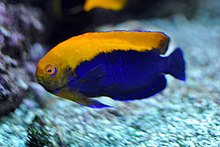Flameback angelfish
| Flameback angelfish | |
|---|---|

| |
| Scientific classification | |
| Domain: | Eukaryota |
| Kingdom: | Animalia |
| Phylum: | Chordata |
| Class: | Actinopterygii |
| Order: | Perciformes |
| Family: | Pomacanthidae |
| Genus: | Centropyge |
| Species: | C. aurantonotus
|
| Binomial name | |
| Centropyge aurantonotus W. E. Burgess, 1974
| |
The flameback angelfish (Centropyge aurantonotus), also known as the flameback pygmy angelfish, Brazilian flameback angelfish, Caribbean flameback angelfish or fireball angelfish, is a
Description
The flameback angelfish has an oval, deep and laterally compressed body with a short, blunt snout and a small mouth. There is a long, robust spine at the angle of the preopercle with vertical margin serrated. To the rear of the bone below the eye there are 2 large, rear-pointing spines and a series of smaller spines on the preopercle and on the opercle.
Distribution
The flameback angelfish is found in the tropical Western Atlantic Ocean. It occurs from the Lesser Antilles and Curaçao in the Netherlands Antilles and along the northern coast of South America from Venezuela to southern Brazil.[1] It has been recorded in the easatern Atlantic at São Tomé in the Gulf of Guinea.[5]
Habitat and biology
The flameback angelfish is found. At depths of between 15 and 300 metres (49 and 984 ft) where it is found in areas of reef and rock rubble.
Systematics
The flameback angelfish was first formally
Utlisation
The flameback angelfish is popular in the aquarium trade and in the 20th Century thousands were exported from Brazil.[1]
References
- ^ . Retrieved 20 November 2021.
- ^ a b c "Species: Centropyge aurantonotus, the Flameback angelfish". Shorefishes of the Greater Caribbean online information. Smithsonian Tropical Research Institute. Retrieved 18 January 2021.
- ^ "Centropyge aurantonotus". Saltcorner!. Bob Goemans. 2012. Retrieved 18 January 2021.
- ^ a b c Froese, Rainer; Pauly, Daniel (eds.) (2019). "Centropyge aurantonotus" in FishBase. December 2019 version.
- .
- ^ Eschmeyer, William N.; Fricke, Ron & van der Laan, Richard (eds.). "Species in the genus Centropyge". Catalog of Fishes. California Academy of Sciences. Retrieved 18 January 2021.
- ^ Christopher Scharpf & Kenneth J. Lazara (21 July 2020). "Order ACANTHURIFORMES (part 1): Families LOBOTIDAE, POMACANTHIDAE, DREPANEIDAE and CHAETODONTIDAE". The ETYFish Project Fish Name Etymology Database. Christopher Scharpf and Kenneth J. Lazara. Retrieved 18 January 2021.
- "Centropyge aurantonotus". Integrated Taxonomic Information System. Retrieved 6 June 2006.
- Froese, Rainer; Pauly, Daniel (eds.) (2006). "Centropyge aurantonotus" in FishBase. May 2006 version.

